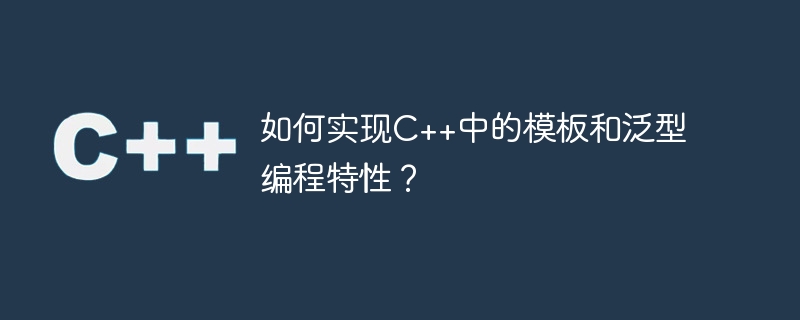

How to implement templates and generic programming features in C?
Introduction:
The template and generic programming features in C are one of the important features of the language. Through templates and generic programming, we can write more versatile, flexible and efficient code. This article will introduce templates and generic programming in C, including the definition and use of template functions and template classes, as well as how to implement some commonly used algorithms and data structures through generic programming.
1. The definition and use of template functions
The template function is a function that can be applied to multiple data types. By using template functions, we can write more general code and reduce code duplication. The following is a sample code for the definition and use of template functions:
#include <iostream>
// 模板函数的定义
template <typename T>
T Max(T a, T b) {
return (a > b) ? a : b;
}
int main() {
int num1 = 10;
int num2 = 15;
std::cout << "Max of " << num1 << " and " << num2 << " is: " << Max(num1, num2) << std::endl;
double num3 = 3.14;
double num4 = 2.71;
std::cout << "Max of " << num3 << " and " << num4 << " is: " << Max(num3, num4) << std::endl;
return 0;
}In the above code, we define a template functionMax## by using template #. This function can be applied to multiple data types (such as int, double, etc.) and returns the larger of the two numbers. In the main function, we use the Max function to solve for the maximum value of two integers and two floating point numbers respectively.
In addition to template functions, C also provides the features of template classes. A template class can be regarded as a general class template that can be used to generate a specific type of class. The following is a sample code for the definition and usage of the template class:
#include <iostream>
// 模板类的定义
template <typename T>
class Stack {
private:
T* data; // 用于存储数据的数组
int size; // 栈的大小
int top; // 栈顶的索引
public:
// 构造函数,对栈进行初始化
Stack(int stackSize) {
size = stackSize;
data = new T[size];
top = -1;
}
// 析构函数,释放内存
~Stack() {
delete[] data;
}
// 入栈操作
void Push(T val) {
if (top == size - 1) {
std::cout << "Stack is full!" << std::endl;
return;
}
data[++top] = val;
}
// 出栈操作
T Pop() {
if (top == -1) {
std::cout << "Stack is empty!" << std::endl;
return T();
}
return data[top--];
}
// 获取栈顶元素
T Top() {
if (top == -1) {
std::cout << "Stack is empty!" << std::endl;
return T();
}
return data[top];
}
};
int main() {
Stack<int> intStack(3);
intStack.Push(1);
intStack.Push(2);
intStack.Push(3);
std::cout << "Top element: " << intStack.Top() << std::endl;
std::cout << "Popped element: " << intStack.Pop() << std::endl;
std::cout << "Popped element: " << intStack.Pop() << std::endl;
std::cout << "Top element: " << intStack.Top() << std::endl;
Stack<double> doubleStack(3);
doubleStack.Push(1.23);
doubleStack.Push(4.56);
std::cout << "Top element: " << doubleStack.Top() << std::endl;
std::cout << "Popped element: " << doubleStack.Pop() << std::endl;
std::cout << "Top element: " << doubleStack.Top() << std::endl;
return 0;
}Stack to implement the function of the stack. A T* data array is used in the template class to store data, and the type T can be any type. In the main function, we used int and double respectively to operate the stack and output the corresponding results.
An important application of generic programming is the implementation of commonly used algorithms and data structures. The following is a sample code for the quick sort algorithm implemented using generic programming:
#include <iostream>
#include <vector>
// 快速排序的模板函数
template <typename T>
void QuickSort(std::vector<T>& arr, int left, int right) {
if (left < right) {
int i = left, j = right;
T pivot = arr[left];
while (i < j) {
while (i < j && arr[j] > pivot) {
j--;
}
if (i < j) {
arr[i++] = arr[j];
}
while (i < j && arr[i] <= pivot) {
i++;
}
if (i < j) {
arr[j--] = arr[i];
}
}
arr[i] = pivot;
QuickSort(arr, left, i - 1);
QuickSort(arr, i + 1, right);
}
}
int main() {
std::vector<int> arr {5, 2, 7, 1, 9, 3};
QuickSort(arr, 0, arr.size() - 1);
for (const auto& num : arr) {
std::cout << num << " ";
}
std::cout << std::endl;
return 0;
}QuickSort to implement the quick sort algorithm. By using generic programming we can sort arrays of any type. In the main function, we define an array of type std::vector, quickly sort it, and finally print out the sorted result.
This article introduces the template and generic programming features in C, including the definition and use of template functions and template classes, and how to implement commonly used algorithms and data structures through generic programming. Through the rational use of templates and generic programming features, the code can be made more versatile, flexible and efficient, and the efficiency of software development can be improved.
The above is the detailed content of How to implement templates and generic programming features in C++?. For more information, please follow other related articles on the PHP Chinese website!
 What drawing software are there?
What drawing software are there?
 Recommended order for learning c++ and c language
Recommended order for learning c++ and c language
 How to withdraw money on WeChat without handling fees
How to withdraw money on WeChat without handling fees
 The performance of microcomputers mainly depends on
The performance of microcomputers mainly depends on
 How to use jsp programming software
How to use jsp programming software
 The Metaverse recognizes the top ten potential coins
The Metaverse recognizes the top ten potential coins
 How to delete a folder in linux
How to delete a folder in linux
 What to do if 302 found
What to do if 302 found
 what is ed
what is ed




